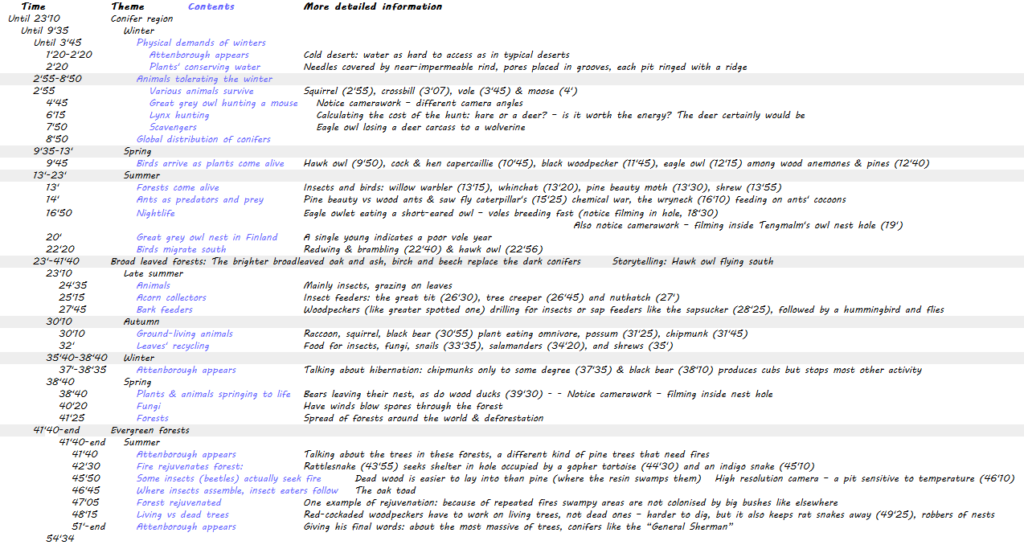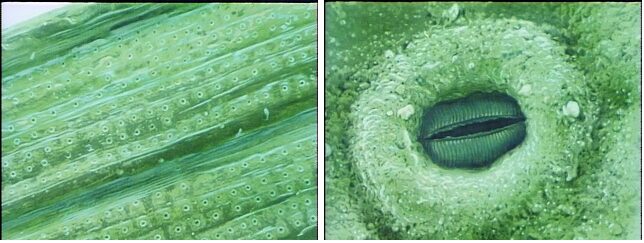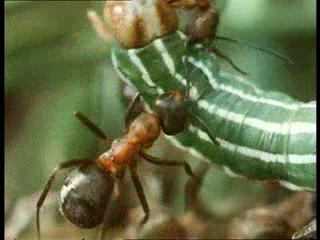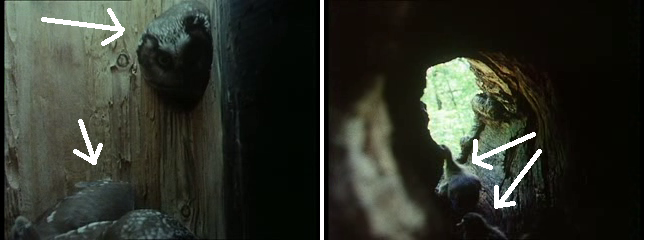Original air date: 2 February 1984

This is probably the most complicated programme in the whole collection if not in his entire career! Without an outline like the one above the viewer may have to listen intently not to miss the clues when the story goes from one type of forest to another. It may feel more like almost the same rhythm repeated continuously.
A more detailed look is in the table below

Selected material
Cold desert

“…Here in northern Norway, 300 miles, 500km north of the Arctic Circle, there is just enough light, but it does get extremely cold. 70 degrees of frost have been measured here, and in winter there are very heavy snowfalls. The cold threatens to freeze the liquid within the trees, and denies them one of their essential supplies: Water. Although snow and ice lie all around, the trees can’t tap that water while it’s frozen. So this land is effectively as parched as a desert and the pine trees have as great a need to conserve water as a cactus.” Attenborough (1’50-2’20)
Selected sequences
Preserving precious water (2’50-2’55)

To avoid losing water through evaporation the pores are well protected. The needles have pores in rows inside grooves (left) and each slit is ringed with a ridge (right). These are almost inedible but the cones are quite edible.
The crossbill’s strange beak in action

Crossbills have specially designed beaks to deal with prying the seeds from cones (33’25-3’30)
An owl catching a mouse (5’45-6’03)

Top frame: the mouse is guilty of an incautious move. The owl spots the mouse and plunges in, to catch it (bottom right). The filming is quite seamless, but notice the different camera angles, very interesting camera work!
Fight among insects

Pine beauty moth caterpillars are very carefully protected against birds, that hunt by sight. This is, however, no defence against wood ants that hunt by smell and touch (14’50).
Chemical warfare among insects

Caterpillar of the sawfly (15’30) uses the resin from the trees as their own weapon. They store some of it in a pouch and dab some on the head of the ant, making it disoriented. Even if it can find its way back home it will smell so strangely its own kind will kill it as a stranger.
A way of telling a story (23′)

A hawk owl is flying south for the winter, and the camera team as well as the story, “hitch a ride”. Similar idea as they ended last episode by using the caribou and the geese!
Examples of filming inside tree holes (19’08 & 39’48)

Filming inside nesting holes demands preparation: cameras have to be installed while the animal (in these cases bird) is absent. On the left is a Tengmalm’s owl nest with arrows pointing at the mother (top) and her chicks. The frame on the right shows two young wood ducks (arrows pointing at them because they are only obvious in videos, not in a single frame). This technique is actually common practice in wildlife film making.
Some animals actually seek fire (46′)

Most animals escape fire but some beetles (left) actually seek it. Dead bark is easier to lay egg in. They have pits behind their legs (right) sensitive to heat, infrared rays.
Coming up:
“As a group, the conifers owe much of their success to their ability to cope with the changeable northern climate. They can survive both the short, dark days of winter with their bitter cold, as well as the long sunny days of summer with their raging fires. But if we continue a further 1,000 miles southwards, we come to the tropics, and there the climate is radically different. It’s no longer very variable but remarkably constant, with much the same amounts of light and rain and heat throughout the year. There the other great group of forest trees, the broadleaved trees, come into their own. That is the jungle, and that’s where we’ll be in the next programme.”